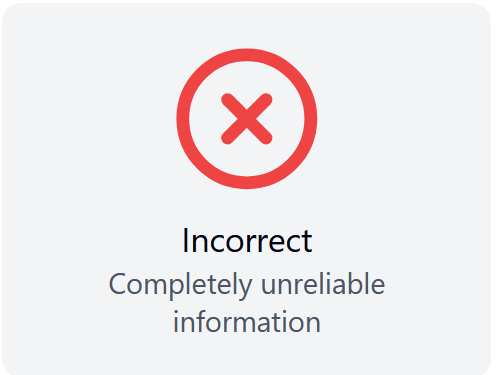On May 7, 2025, a story appeared on the CTV YouTube channel: “EU continues to abuse migrants.” The video gathered more than 600 thousand views. It stated:
The European Union continues the abuse of migrants at our border. Latvian border guards threw a refugee’s body onto Belarusian territory. It was discovered this morning. An investigative team is working at the scene. The circumstances of the foreigner’s death are tragic. The man was found in a ditch, right by the border fence. The body, without shoes, documents, and phone, was pressed down by a log, and the head was submerged in water. Specialists are now trying to establish the nationality of the deceased.
Our verdict based on the analyses conducted:
Verdict: Incorrect
Reasons:
- The thesis or statement is completely false: information from multiple sources or opinions of several experts in the specific field contradict it.
- Cause-and-effect relationships and connections clearly do not exist as claimed.
- When quoting, substantial parts are omitted, rearranged, changed, or incorrectly translated from a foreign language, resulting in a fundamental change in the meaning of what was said.
- The event occurred substantially differently than claimed.
Full video:
Probable actor: state or proxy media from Belarus or Russia
Type of interference: DIMI with elements of FIMI, aimed at:
-
discrediting EU countries (particularly Latvia);
-
inciting anti-European sentiments within Belarus;
-
legitimizing the state position of Minsk, which accuses the EU of humanitarian crimes.
2. Information manipulation tactics
| Category | Description |
|---|---|
| Decontextualization | Source is not indicated; information may be taken out of context or fabricated |
| Emotional exploitation | Emphasis on cruelty, death, suffering — to arouse anger and sympathy |
| Unverified attribution | Accusation against “Latvian border guards” without evidence |
| Obfuscation | Lack of precise data: no time, names, official statements |
| Narrative laundering | Message presented as “news,” but without signs of journalistic standards |
3. Content characteristics (according to EU FIMI typology)
| FIMI type | Examples in the text |
|---|---|
| False context | Presenting a possible staged event as fact |
| Fabricated content | Mention of “throwing the body” without confirmation |
| Manipulated content | The headline (“EU abuses”) and style create a false impression of systematic violence |
| Imposter content (possible) | If presented as “news” from pseudo-media |
4. Meta-narratives and structure
Key narrative:
-
”The EU is an immoral, cruel, inhumane player”, especially toward migrants.
-
The story echoes the official Belarusian rhetoric since the migration crisis of 2021.
Sub-narratives:
-
The EU allegedly violates human rights and international law.
-
Belarus is allegedly the humanitarian side, documenting the “West’s” crimes.
5. Categorization: FIMI or DIMI?
| Category | Arguments |
|---|---|
| DIMI | Created for Belarus’ domestic audience; aimed at supporting the state narrative and mobilizing the population |
| FIMI | Potential distribution abroad; may be translated/distributed by proxy actors (RT, Sputnik) |
The text clearly falls under DIMI, but when distributed through transnational proxies, it can also perform FIMI functions.
Conclusion
| Criterion | Assessment |
|---|---|
| Type of interference | DIMI, with possible FIMI continuation |
| Manipulation methods | Emotions, false context, lack of sources |
| Goal | Undermining trust in the EU, mobilizing support for Minsk |
| Fact-checking result | Lack of confirmation; probability of staging |
Let’s analyze the disinformation narratives and perform a semantic analysis:
The claim that Latvian border guards ‘threw a refugee’s body’ onto Belarusian territory can be interpreted as manipulation, as no evidence or context is provided to confirm this action.
lack of verifiable sources
Using the tragic situation with a refugee’s body to create an emotional response in viewers, which may distort the perception of events.
appeal to emotions
The content contains manipulative elements and emotional exploitation, which may distort the perception of the migrant situation.
migrants
border conflicts
negative
shock
anger










